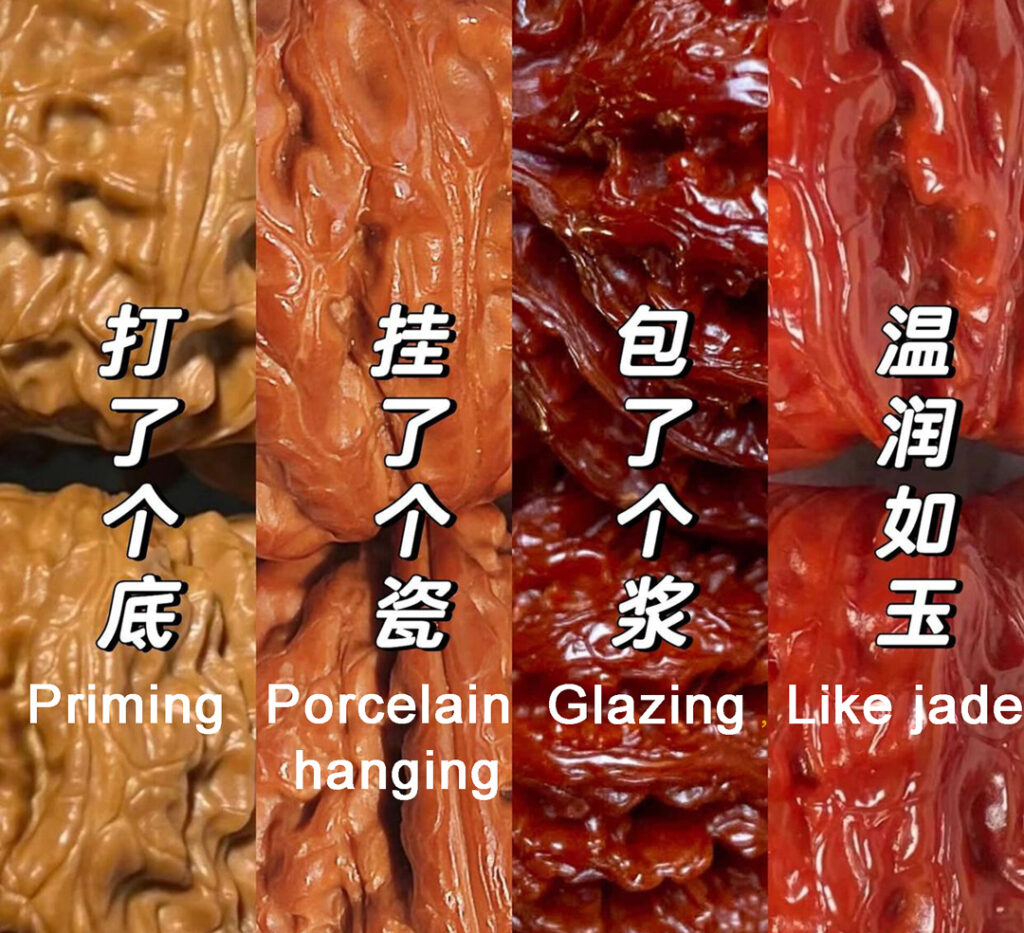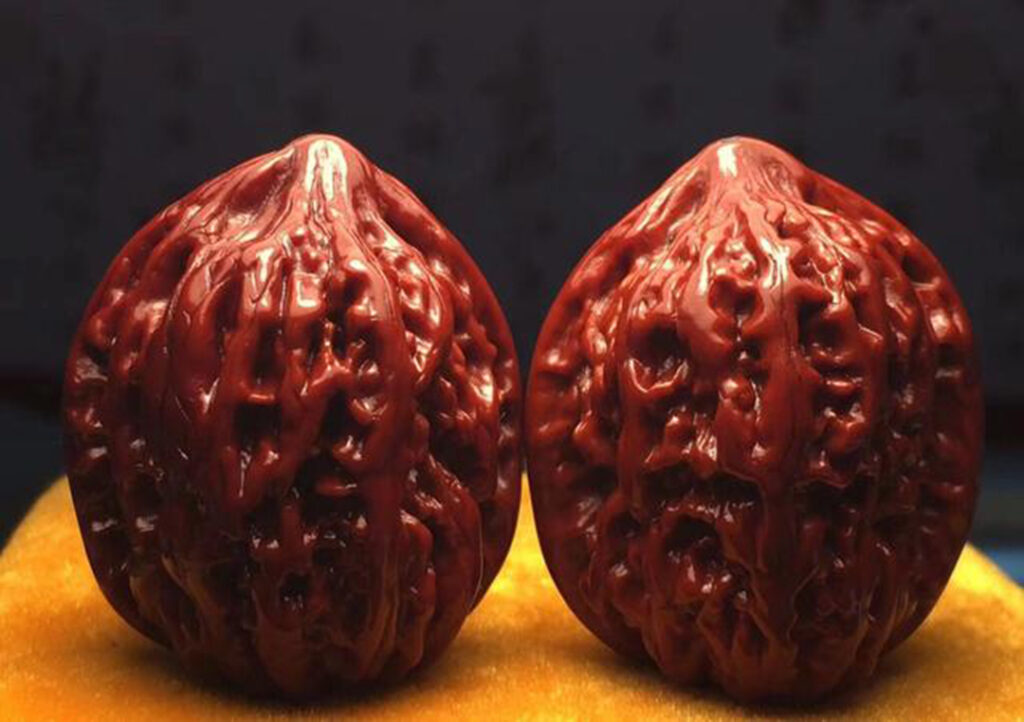
Yunmeng Jia remembers the scene of her childhood, with venerable elders restlessly fondling their pair of precious walnuts.
When I was a child, I always knew that the walnut, a type of traditional Chinese handgrip, was a common item for grown-ups to play with. As a child, I watched them effortlessly twirl two walnuts in one hand, akin to windmills, creating a soothing symphony of rustling whispers. My earliest and most vivid memories of these walnut treasures take me back to my primary school days.
One day during a nature class, the teacher shared a captivating story about an elderly gentleman who had lovingly polished a pair of walnuts for over half a century. Their lustrous appearance, bathed in the glow of history, eventually caught the eye of an esteemed walnut connoisseur who offered a substantial sum of money to claim them. The elderly man was initially delighted but he thought that the walnuts had become too dirty from years of handling, so he decided to wash them with water before selling them. To his surprise, the expert cancelled the deal when he received the washed walnuts, saying, “I wanted the natural hand oils on these walnuts!”
These play walnuts, known as “文玩核桃” in Chinese, stand as among the most beloved collectibles in China. They undergo special processing to make them valuable for collectors. Compared to ordinary walnuts, play walnuts are larger, smoother, and have more exquisite patterns on their surfaces. The playing technique involves holding a pair of walnuts in one hand and repeatedly rotating and rubbing them. Over time, the walnuts absorb the natural oils from the hands, making them appear translucent, glossy, and red-toned.
The tradition of playing with walnuts can be traced back to the Ming Dynasty. Initially, it served as an auxiliary tool for court musicians to train and maintain their finger dexterity. Over an extended period of handling, the walnuts developed rich, maroon patterns, a glossy sheen akin to jade and porcelain, and became beloved by other court members. Gradually, this practice gained popularity and spread among the general populace, emerging as a wellness tradition. In folklore, walnuts found quick acceptance among ordinary people, and the number of enthusiasts increased, culminating in a cultural trend.
The value of a pair of play walnuts depends on the degree of handling and playing they have received. As walnuts absorb hand oils and undergo oxidation, their colour changes. Initially, they are a deep brown, but with prolonged handling and absorption of hand oils, they develop shades of dark red or maroon. After extended periods of handling, the texture, density, and hardness of the walnuts change, becoming finer, denser, and harder, and their lustre becomes translucent. The sound of playing with these walnuts shifts from a dull thud to a crisp sound, reminiscent of striking jade or porcelain. The most valuable walnut handgrip can be worth millions of RMB and may be over a century old, with some dating back to the Qing Dynasty.

Collecting and playing with walnuts is a pastime that dances in harmony with the ebb and flow of time, a subtle tango with the passage of years. It takes at least half a year for the walnuts to turn red during this hobby. Of course, the time required may vary depending on the walnut variety. Some varieties like “白狮子”(White Lion),“满天星”(Full Sky),and“红狮子”(Red Lion) are relatively easy to turn red, while others like “鸡心”(Chicken Heart) and“南疆石(Southern Xinjiang Stone) may take more than 5 years to achieve this transformation.
There are many details to consider when cracking and playing with walnuts, primarily in terms of maintenance. Before cracking, the walnuts should be cleaned thoroughly in lukewarm water and then rubbed repeatedly in clean gauze to create a certain polishing effect. Regular collectible walnuts often undergo a deep cleaning process, which involves the use of a wire brush to remove any remaining flesh from the surface. Subsequently, a pig bristle brush or a softer pig hair brush is used for daily cleaning and polishing. Afterwards, the walnuts can be taken into the hands for playing. During the play, they should be repeatedly kneaded in the hands to ensure that every part is properly cracked and polished.
The community of walnut enthusiasts typically consists of middle-aged and elderly men. In my childhood memories, I associated them with a group of middle-aged men with a strong odour of cigarettes and alcohol, sitting at barbecue stalls on the roadside, eating meat, drinking, and discussing business, politics, or venting about their wives. They were not always talking about topics suitable for my young ears, but they seemed to cherish these gatherings as a way to relieve stress and enjoy themselves. Holding a pair of walnuts in one hand while smoking a cigarette, their little fingers might even have long fingernails.
Alternately, there were clusters of elderly gentlemen leisurely seated beneath grand trees by the street, each equipped with a chair and a pair of walnuts gripped firmly in their hands. With concerted effort, they squeezed and rubbed the walnuts vigorously, producing a sonorous and rhythmic symphony. These individuals, with elongated, yellowed nails, commanded an aura of dignity and authority. Walnut players also exhibited two distinct styles: “文盘” (gentle playing), wherein the walnuts turned silently and smoothly in the palm without a hint of noise, and “武盘”(vigorous playing), where walnuts were engaged in an exuberant, physical dance of compression, friction, and exuberance. Walnut players tended to reserve their “文” style for home, mindful of not disturbing their spouses, while outside, they unapologetically indulged in “武” style, where they flaunted their expertise and extended invitations to kindred spirits.

My second memory related to play walnuts involves my elementary school math teacher. He was a middle-aged man with a few silver strands in his hair, but what stood out the most was his stubbled face. He always had a pair of walnuts in his hands, and I recall him playing with them silently in the teacher’s office while trading stocks on the school computer.
His walnuts were deep red, glossy, and resembled carnelian. He belonged to the “gentle playing” style, rotating the walnuts in his palm silently. I heard that he had been playing with handgrip walnuts for over 20 years and could expertly discern the authenticity of these artifacts. As children, we were a bit intimidated by him, especially the female students, perhaps because there were few male teachers in Chinese schools at the time, and he was the first male teacher I had encountered. Boys often gossiped about him, alleging that he touched some of the female students, but when asked if they had witnessed it themselves, they were unable to provide any concrete evidence. Other teachers often discussed his personal life, mentioning that his wife had passed away when he was relatively young, and that he had both a teaching job and a side business involving handgrip walnuts.
After his wife’s death, he became more reserved and focused on teaching. He never remarried after her passing, and perhaps, like the walnuts he cherished, he had smoothed out and matured with time.
Before writing this article, I interviewed someone who buys and sells walnuts. When I asked him why he enjoyed dealing with walnuts, he said, “It brings real joy and fun. In the past, when a few people got together, if someone could buy a pair of walnuts that had been well played with and had a great appearance, it was so enjoyable. We’d all compete to treat each other to meals. Back then, these walnuts were hard to come by. Who would be willing to sell their walnuts? They’ve been with us for decades, and if it weren’t for financial difficulties, no one would part with them.” \
“People are like passing guests in the walnut’s world.”
People have a unique connection with walnuts as they represent a sense of stability, contentment, or nostalgia. He also added, “People are like passing guests in the walnut’s world. Those who play with walnuts serve them. No matter how small or inexpensive they may seem, people are the ones who ultimately shape them into their current state. Unlike other antiques like Ming Dynasty redwood or Huanghuali furniture, which are meant to be enjoyed by people, walnuts are unique. They reflect the effort and care people have invested in them, and their value comes from both the walnut itself and the memories and emotions they carry. It’s a connection between people and an inanimate object.”
Emperor Qianlong of the Qing Dynasty even wrote a poem about these walnuts: “掌上旋明月, 时光欲倒流, 周身气血涌, 何年是白头,” which translates to “Spinning the bright moon in the palm, wishing to turn back time, energy and blood flow within, when will the hair turn white.” People find a sense of tranquillity that originates from within themselves. These hand-held walnuts, like the people who play with them, evolve and mature over time. In today’s society, where human relationships are often strained, and connections between individuals grow distant, there is one constant—the walnut, always present in people’s hands.
The sound of two walnuts colliding each time symbolises a form of communication, evolving from a dull thud to a melodious and crisp resonance. Just as walnuts change and improve with time and care, so do the individuals who nurture them.
About Yunmeng Jia
 My name is Yunmeng Jia, born in Beijing and currently residing in Melbourne. I am a student pursuing a Master of Communication Design at RMIT. My research focuses on critical design and Chinese craftsmanship. My work aims to challenge the things that people take for granted in society. I always use design to attempt to subvert the ideologies conveyed by these things and expose their modernity. At the same time, I have been consistently interested in the study of Chinese traditional craftsmanship, and my work incorporates many visual elements of Chinese craftsmanship. I enjoy exploring the relationship between craftsmanship and people; I believe that the connection between objects and people is the most wondrous thing!
My name is Yunmeng Jia, born in Beijing and currently residing in Melbourne. I am a student pursuing a Master of Communication Design at RMIT. My research focuses on critical design and Chinese craftsmanship. My work aims to challenge the things that people take for granted in society. I always use design to attempt to subvert the ideologies conveyed by these things and expose their modernity. At the same time, I have been consistently interested in the study of Chinese traditional craftsmanship, and my work incorporates many visual elements of Chinese craftsmanship. I enjoy exploring the relationship between craftsmanship and people; I believe that the connection between objects and people is the most wondrous thing!

